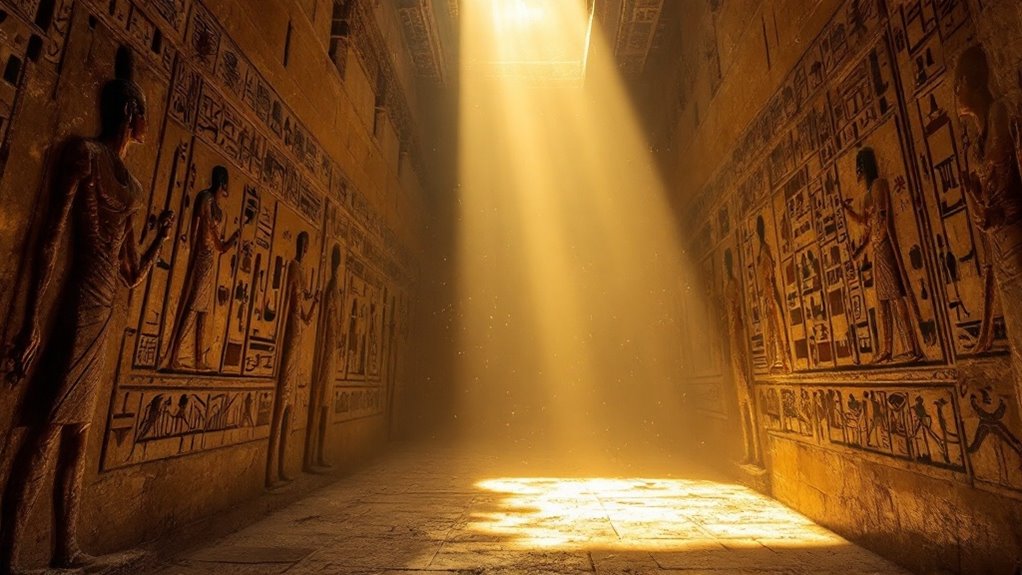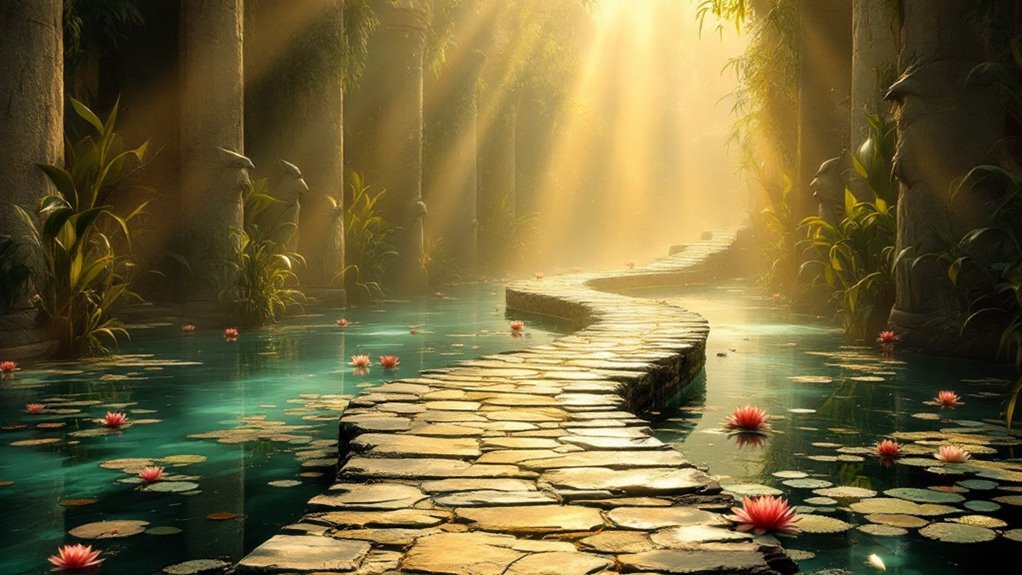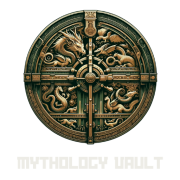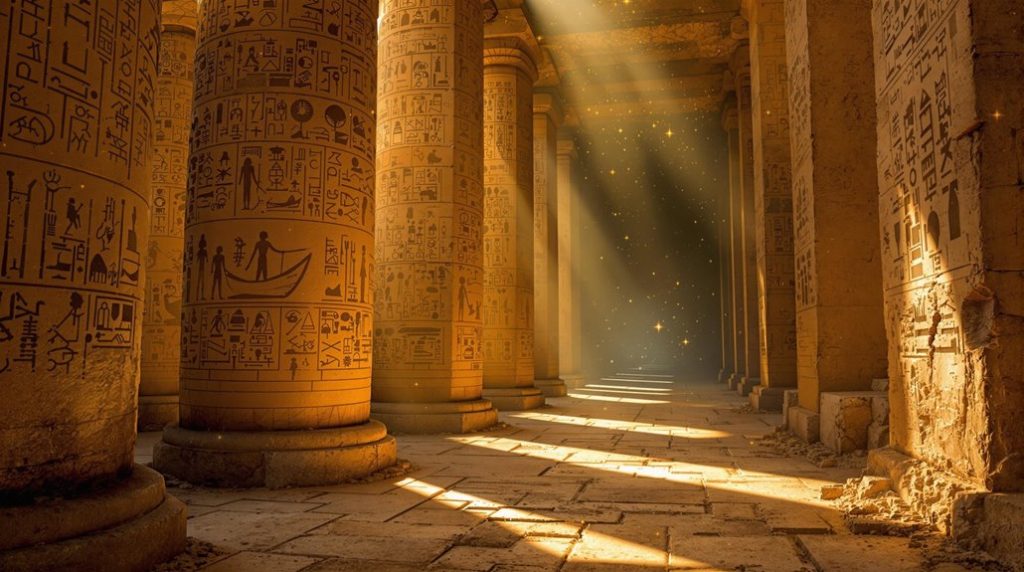Over 1,200 unique spells and incantations from ancient Egypt have been unearthed, all designed to help souls navigate the treacherous pathways of the Duat.
These mystical passages bear striking similarities to otherworldly journeys found in various world mythologies, such as Orpheus's descent into Hades and the Norse hero Hermod's ride to Helheim. What sets the Egyptian concept apart, however, is its sophisticated understanding of consciousness—dividing the soul into Ba and Ka, each requiring its own spiritual transformation.
As we delve into the Duat's labyrinthine mysteries, you'll discover that its ancient wisdom continues to challenge our modern assumptions about existence and mortality.
The Entrance to Duat
The ancient Egyptians viewed the entrance to Duat as a pivotal gateway between the mortal world and the afterlife. This celestial passageway, often depicted above grand pyramids and tombs, marked the beginning of a deceased person's journey towards eternal liberation. The Duat was represented in hieroglyphs as a star within a circle.
According to ancient beliefs, upon death, a person's essence split into two components – the Ba and Ka. As the Ka crossed the threshold into Duat, it encountered Anubis, the guardian of this ethereal realm. The god assessed the soul's readiness to embark on a transformative journey through the underworld.
The ancient priests created intricate guides, known as the Books of the Dead, to aid souls in navigating the twelve gates of Duat. Each gate presented a unique challenge, testing the individual's spiritual worthiness. Time was of the essence, as the Ka had to complete this perilous journey before the physical body succumbed to decay. Protective spells and incantations were used to ward off the darkness and ensure a safe passage.
The journey through Duat was a complex and potentially treacherous ordeal. However, for those who were properly prepared and deemed worthy, it represented a crucial step towards achieving immortality in the afterlife.
Guardians of the Netherworld Gates
Beyond the threshold of the Egyptian underworld, Duat, an impressive array of gate guardians stood watch. Those who sought to pass into the afterlife first had to confront these fierce hybrid beings – part animal, part divine. The guardians went by menacing names like "swallower of sinners" and "existing on maggots", striking fear into the hearts of those who wished to enter. Yet, paradoxically, they also served as crucial guides for souls navigating the perilous transformation into the afterlife.
These twelve enigmatic guardians, like the cat-headed Qed-Her with his twin serpents, held vigil at each gate. To gain passage, the deceased had to utter their secret names – a test that separated the worthy from those who would be devoured. During the twelve dark hours of night, the guardians worked alongside goddesses to transform souls and protect the sun god Ra as he journeyed toward rebirth. Funerary texts inscribed on tomb walls and coffins provided the deceased with these vital passwords and spells needed to successfully navigate past each guardian.
Sacred Texts Guide the Dead

Egypt's "Book of the Dead" is one of history's most enigmatic spiritual guides. This collection of sacred spells and incantations illuminated the path through Duat's shadowy domain. The Book served as both a map and key, enabling souls to speak the right words at essential moments. This is similar to how modern seekers use ancient wisdom to gain insight into life's mysteries.
The spells in the Book weren't random. They were carefully compiled instructions for spiritual transformation. The ancient Egyptians used these texts to overcome supernatural gatekeepers and hazardous landscapes. The sacred knowledge transformed the ba (personality) and ka (life force) into an enlightened akh. This is similar to how we seek to integrate our own fragmented selves. The manuscripts were often prepared for burial to ensure the deceased had guidance in the afterlife.
The Book of the Dead wasn't just a guide for the afterlife. It was a tool for spiritual growth and self-discovery. The ancient Egyptians believed that by understanding the journey of the soul, one could better navigate life's challenges. This wisdom can still be applied today, as we face our own trials and seek enlightenment.
Osiris and Soul Judgment
Underworld justice flows through Osiris, resurrected ruler over the afterlife. To claim my eternal existence, I must face his judgment. In his court, I'll confront 42 divine judges testing my truth against Ma'at's sacred feather.
Like new life sprouting from the earth, I'll navigate spiritual rebirth. I must be pure – if my heart's heavy with wrongdoing, Ammut's jaws await. If I'm worthy, Osiris welcomes me to the Field of Rushes, tending mystical crops under eternal blue skies. This heart scarab keeps my conscience true, armed with sacred texts to speak my truth.
Field of Eternal Paradise

Ancient souls step into A'Aru, the Field of Reeds, where eternal springtime mirrors Egypt's cultivated lands. This paradise brings equality to the afterlife, where both rich and poor farmers work together in this idealized domain under the watchful eyes of the gods.
You'll discover your familiar surroundings restored: beloved trees whisper ancient secrets, streams flow with memories of past lives, and cherished pets bound joyfully at your return. No pain exists here, no suffering, no shadow of death's touch. This vision of eternal bliss evolved from Egypt's earliest days until the Middle Kingdom perfected it. In this mirror world to the west, you'll find everything you've lost restored, living forever in the presence of divine beings who welcome you home.
Frequently Asked Questions
Could Souls Communicate With Living Relatives Through the Gates of Duat?
While souls couldn't directly speak through Duat's gates, ancient Egyptians found other sacred ways to bridge the gap between worlds. Mortuary chapels provided a space for family and friends to make offerings and speak to the deceased. False doors carved into monuments gave souls a threshold between the afterlife and the physical world to cross through.
The ancient Egyptians also placed written letters, messages and boundary stelae in tombs for deceased loved ones. These texts spanned simple "I love you"messages to a coachman named In-hApi's letter to his deceased wife listing all the things he was sending her in the afterlife, like wooden chairs, beads, cosmetics and cattle.
What Happened to Souls Who Got Lost Between Gates in Duat?
I'll tell you a chilling truth about the Ancient Egyptian belief system and the underworld called Duat. According to Egyptian beliefs, souls that got lost between its gates faced an awful fate – eternal wandering. Those souls were unable to reach Osiris's kingdom and without proper spells or names, they would fade into non-existence, which was considered worse than death itself.
Did Ancient Egyptians Believe Animals Could Enter and Navigate Duat?
Ultimately, when it comes to the question of whether ancient Egyptians believed that animals could enter and navigate Duat, the underworld in their cosmology, the answer seems to be no. While animals played a significant role in Egyptian spirituality, often serving as symbols for various deities and spiritual concepts, they weren't seen as independent entities that could traverse the underworld like human souls.
The Egyptians saw animals, especially sacred creatures, as possessing divine power and significance, but their role was more symbolic and associative, rather than as active participants in the underworld journey that deceased humans faced. The complex and highly structured process of transitioning through Duat, as depicted in funerary texts like the Book of the Dead, was primarily reserved for human souls.
Were There Different Sections of the Field of Reeds for Different Professions?
In my study of ancient Egyptian texts, I have not come across any evidence that suggests the Field of Reeds was divided based on professions or social status. Instead, the descriptions paint a picture of an idyllic afterlife where all souls, regardless of their earthly occupations or standing, received equal plots of land. This idea of an egalitarian existence is a striking contrast to the hierarchical society of ancient Egypt.
The concept of the Field of Reeds is often associated with the Book of the Dead, a collection of spells and prayers meant to guide the deceased through the afterlife. The texts describe it as a place where the souls of the dead would live a utopian lifestyle, free from the troubles and inequalities of the earthly world.
The idea of a-posthumous existence where all souls are treated equally reflects the ancient Egyptian belief in an afterlife where one's worth was measured by their adherence to ma'at – the concept of truth, balance, order, harmony, justice, morality, and law that was central to their religion and worldview.
While the Field of Reeds is a prominent feature of ancient Egyptian funerary texts, the lack of clear evidence for professional or social divisions suggests that the afterlife was not simply a mirror of earthly society. Rather, it represented a transformative space where individuals could transcend their mortal limitations and find equality in the pursuit of an idyllic existence.
Could Souls Choose to Be Reborn as Someone Else After Reaching Paradise?
The ancient Egyptians had no such belief about choosing new identities once they reached the afterlife. For them, the soul's journey was all about carrying on as your true self for eternity – not about turning into someone else entirely.


